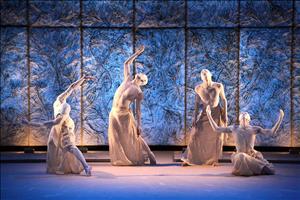On September 10, 1985, the Sankai Juku dance company from Japan performs in Seattle's Pioneer Square, with the dancers hanging upside down from a building as a metaphor for life and death. Soon after the dance begins, the rope holding dancer Yoshiyuku Takada (1954-1985) breaks, sending him five stories to his death.
Art of the Dance
Sankai Juku debuted in Tokyo in 1978, born out of Butoh, a dance theater movement that took root in Japan following World War II and blossomed in the 1960s. Butoh -- which came from the Japanese term "Anokoku-Buyuo" (Dance of Darkness) -- was conceived as underground art, and as a revolt against both Western culture and traditional Japanese art forms. Early Butoh performances were oftentimes violent, grotesque, and sexually graphic.
Ushio Amagetsu (b. 1949) founded Sankai Juku in 1978 with the goal of redefining the dance movement into a new form that showcased its more gentle and poetic aspects. Amagetsu started a series of workshops in 1975 to form his new dance company, but of the 25 workshop participants, only three became members of the troupe. One of those was Yoshiyuku Takada.
Jomon Sho
The five-man company toured the world, and made their American debut at the Olympic Arts Festival in Los Angeles in 1984. Many times when they performed in a new city, the dancers opened their residency with a performance entitled "Jomon Sho" (Homage to Prehistory). In this piece, the performers -- whose bodies were shaved of hair and covered head to toe in white rice flour -- were suspended upside down by ropes attached to their ankles. They would begin the dance in the fetal position, and slowly writhe and undulate while being lowered to earth. The performance lasted for 30 minutes, and was described by promoters as a "dance of life and death."
In 1985, Sankai Juku chose Seattle as the starting point for its second tour of the United States. Working with On the Boards -- a Seattle production company -- the dancers secured permission from the owners of the Mutual Life Building in Pioneer Square to perform "Jomon Sho" from the building's rooftop. The dance company spent days building a scaffold atop the Yesler Way side of the structure and handing out yellow photocopies advertising the event.
Life and Death
By late morning on September 10, several thousand people had gathered in Pioneer Square to see the lunchtime performance. Promptly at noon, Ushio Amagetsu appeared on top of the building and blew on a conch shell. The crowd went silent as four white, nearly naked, dancers inched out over the platform and swung out into space, their feet in the air, their backs to the ground.
A minute or two after the dance began, Yoshiyuku Takada knew something was wrong. He looked up at his rope and saw that it was starting to fray. Slowly he reached up, attempting to grab the rope above the section that was rapidly beginning to unravel. In an instant, the rope snapped and Takada fell 80 feet to the ground. During his descent, he did not flail, nor did he scream. When he slammed into the pavement, his body makeup sent up a small puff of powder into the air.
During his fall, the crowd gasped and screamed, but afterwards they went silent, in shock from what they had just seen. Dr. Forrest M. Darrough, a Seattle physician who was sitting on the sidewalk just ten feet from where Takada's body hit, rushed over to help the injured man. Takada had compound fractures of the left elbow and shoulder, and severe head trauma.
Darrough began administering cardio-pulmonary resuscitation with the help of an unidentified woman from the audience. They were able to get air in and out Takada's lungs, but he was unable to breathe on his own. They continued to apply CPR until ambulances arrived, and then walked back into the crowd, their hands and faces white with powder. Takada was declared dead at Harborview Medical Center at 12:24 that afternoon.
Honoring the Performer and his Art
In Pioneer Square, people were still numb from witnessing the death. Many cried and embraced. The thick rope that had broken was taken into police evidence, and afterward people began laying flowers and messages at the spot where Takada hit the ground.
It was later determined that the dancers had tested only one of the four ropes used in the performance. Takada's rope was one that was not tested. The troupe had also asked for old, used ropes, as newer ropes tend to spin the dancers around, and the dance required ropes that remained steady.
On September 12, a candlelight ceremony was held for the fallen dancer in nearby Occidental Park. Some who attended were those who witnessed his death two days before and were still haunted by the accident. Late in the ceremony, Takada's parents arrived to pray with them. Speaking through an interpreter, Takada's parents told the crowd, "Thank you very much for taking the time and coming here for my son. I am very grateful." Afterwards, Takada's family went to the base of the building where the son had died and prayed some more.
Perseverance
Sankai Juku canceled the rest of its 10-city tour that year and returned to Japan. Amagetsu considered dissolving the group, but Japanese supporters, including Takada's family, urged him to continue.
The dance company returned to the stage in 1986, with a show in Paris. From there, Sankai Juku returned to Seattle on April 17, 1986, for a performance of "Kinkan Shonen"(the Kumquat Seed) at the Opera House. Amagetsu stated, "We cannot tell (you) how important it is for us to start our U.S. tour on a stage in Seattle -- not anywhere else" (Seattle Post-Intelligencer, April 11, 1986).
For the duration of the 1986 tour, Sankai Juku performed no hanging outdoor dances, but the company has since reintroduced them to its repertoire.

